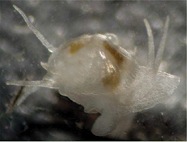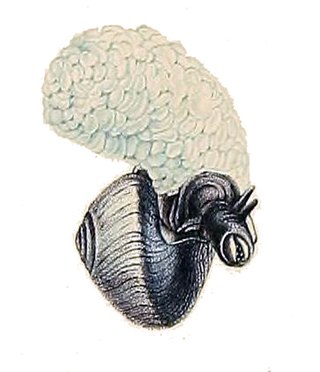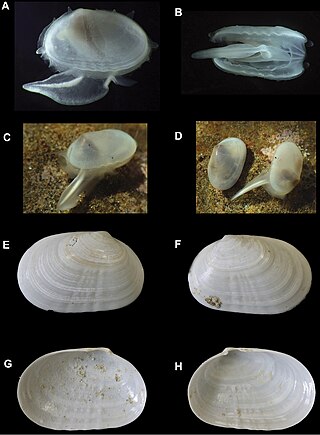
Bivalvia, in previous centuries referred to as the Lamellibranchiata and Pelecypoda, is a class of marine and freshwater molluscs that have laterally compressed bodies enclosed by a shell consisting of two hinged parts. As a group, bivalves have no head and they lack some usual molluscan organs, like the radula and the odontophore. The class includes the clams, oysters, cockles, mussels, scallops, and numerous other families that live in saltwater, as well as a number of families that live in freshwater. The majority are filter feeders. The gills have evolved into ctenidia, specialised organs for feeding and breathing. Most bivalves bury themselves in sediment, where they are relatively safe from predation. Others lie on the sea floor or attach themselves to rocks or other hard surfaces. Some bivalves, such as the scallops and file shells, can swim. Shipworms bore into wood, clay, or stone and live inside these substances.

Corbicula is a genus of freshwater and brackish water clams, aquatic bivalve mollusks in the family Cyrenidae, the basket clams. The genus name is the Neo-Latin diminutive of Latin corbis, a basket, referring to the shape and ribs of the shell.

Tridacna crocea, the boring clam, crocus clam, crocea clam or saffron-coloured clam, is a species of bivalve in the family Cardiidae. It is native to the Indo-Pacific region. It is occasionally found in the aquarium trade where it is often simply referred to as crocea.

Galeommatidae is a family of small and very small saltwater clams, marine bivalve molluscs in the order Galeommatida.

Thyasiridae is a family of bivalve molluscs, including the cleft clams, in the order Lucinida.

Poromyidae is a family of saltwater clams, marine bivalve molluscs in the order Anomalodesmata. The genus Dilemma, described in 2008, is remarkable for being a predator of copepods, which is very unusual for a sessile mollusc.

Janthina janthina is a species of holoplanktonic sea snail, a marine gastropod mollusk in the family Epitoniidae. Its common names include violet sea-snail, common violet snail, large violet snail and purple storm snail.

Glaucus is a genus of small blue pelagic sea slugs. They are aeolid nudibranchs, ranging in size from 20 to 40 mm. They feed on colonial cnidarians such as Portuguese man o' wars, blue buttons, and purple sails. They can produce painful and potentially dangerous stings when handled, as they store the venomous nematocysts of their prey. Glaucus is the only genus in the family Glaucidae. It includes five species.

Periglypta is a genus of bivalves in the subfamily Venerinae of the family Veneridae.

Hysteroconcha lupanaria is a species of marine bivalve mollusc in the family Veneridae, the Venus clams.

Brisaster latifrons is a species of sea urchins of the family Schizasteridae. Their armour is covered with spines. Brisaster latifrons was first scientifically described in 1898 by Alexander Emanuel Agassiz.

Tucetona is a genus of saltwater clams, marine bivalve molluscs in the family Glycymerididae, the bittersweet clams. Unlike other genera in the family, Tucetona species have a ribbed shell.

Propeamussium is a genus of saltwater clams, marine bivalve mollusks in the order Ostreoida.
Ascetoaxinus is a genus of saltwater clams, marine bivalve molluscs in the family Thyasiridae. The shells of species in this genus have a lunule with a scalloped margin.

Pleurolucina is a genus of saltwater clams, marine bivalve molluscs in the subfamily Lucininae of the family Lucinidae.

Pourtalesia miranda, commonly known as the wonderful sea urchin, is a species of sea urchin in the family Pourtalesiidae. It is found at abyssal depths in the Atlantic Ocean.

Pandora is a genus of small saltwater clams, marine bivalves in the family Pandoridae.

Cymatioa cookae, also known as Cymatioa cooki, is a species of saltwater clam, a bivalve mollusk, that is native to southern California. It was thought to be extinct since the Pleistocene era until four specimens were found living in Santa Barbara, California, between 2018 and 2019.
Grippina is a genus of bivalves in the family Spheniopsidae which currently consists of nine species. It was first described by William Dall in 1912 with G. californica recorded in the eastern Pacific Ocean near California, US. Their habitat spans across the Pacific Ocean, mainly centering around Australia and New Zealand, though G. coronata was found in 2015 off the coast of Rio de Janeiro, Brazil in the western Atlantic Ocean. Bivalves in the genus Grippina are part of the order Anomalodesmata, also known as septibranchs, which are carnivorous clams. They use their inhalant siphons, adapted with sensory papillae to detect motion, to inhale microscopic crustaceans such as ostracods. As sessile, benthic predators, they lie in wait under sand and stick their siphons out into open water to feed. Their shells range in size from about 2–5 millimeters.



















